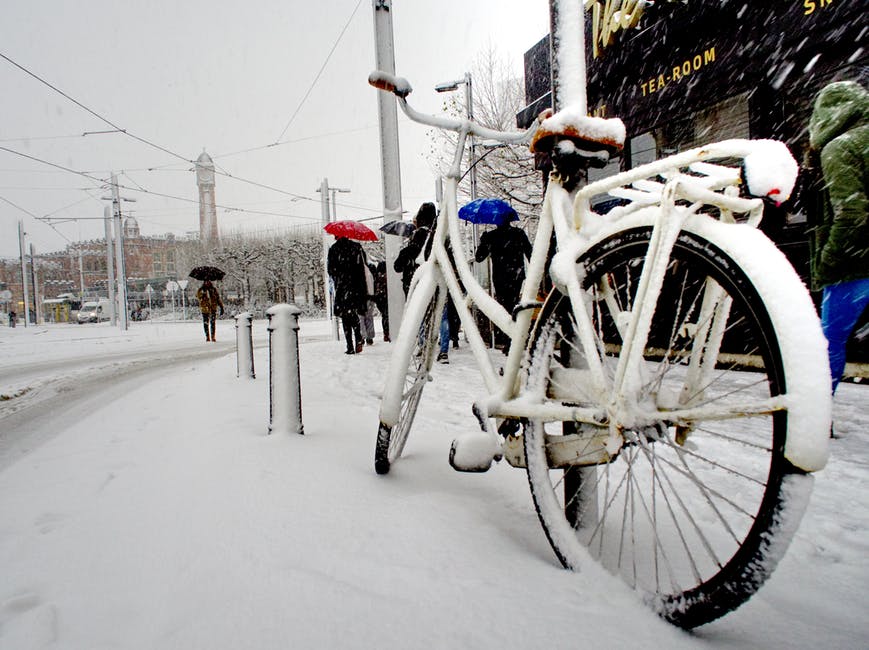Written By: William Keele and Krystal Leonov, Student-at-Law
Tips for Winter Cycling
Many cyclists hang up their bikes after the first sign of snow. However, with some bike preparation, a good route and the right clothes you can extend your cycling season throughout the winter months. And as an added bonus, you also burn more calories cycling in the winter as your body fights harder to stay warm. It is the perfect time to unhook that bike and stick to those new years resolutions!
The following is what you should – and shouldn’t – do to make the most of your winter cycling season:
DO Layer Clothing
Always start with a warm base layer. This may sound obvious, but your hands and feet become cold when your core temperature drops as your body diverts warming blood flow away from your extremities.
You also need to realize that you’re going to be cold – at first. According to bike advocates, you shouldn’t be warm when you get outside, ready to ride. If you are, you have too much clothing on. You want to be able to move freely and you also don’t want to arrive at your destination drenched in sweat.
DON’T Buy a New Bike
Fat bikes are cool, but you don’t necessarily need four-inch tires to ride in the snow. Winter cycling can be rough on your bike so rather than risking your primary bike, opt for that mountain bike gathering dust in the back of your garage (if you have one). Mountain bikes also have wider tires with deeper grooves and treads which are helpful because they are less likely to slide when riding through ice and snow.
For more stability in the snow, you can run on a lower tire pressure without the risk of getting a flat. Depending on your weight, you might be able to ride 15 psi or lower in order to get a better grip on the road. However, if you live in an area with a regular freeze/thaw cycle, you may want to invest in studded tires. These tires have good traction and small metal protrusions grip nicely onto slippery ice patches.
For lightly packed snow or slush, thin tires can be very effective for cutting through the snow to reach the pavement. It’s best to know the conditions that are most common in your area and choose your tires accordingly.
DO Wash Your Bike After Every Ride
Riding in snow and slush will kick a lot of salty, dirty water onto your bike. This can cause corrosion and damage over time so be sure to wash your bike, or at least wipe it down, as soon as you finish your ride.
Bike mechanics recommend spraying WD-40 on the frame before a ride to help repel ice and grime. After the post-ride cleaning or wipe down, spray it on your bike chain to get rid of excess moisture.
DON’T Ignore Your Extremities
Your hands and feet typically are the first to get cold; therefore, it’s important to keep them very warm. An interesting tip used by bike mechanics is to wear disposable surgical gloves under your regular gloves as it creates an extra vapor layer between your skin and the cold. This technique can actually make your hands a little sweaty but it’s a better alternative to frozen fingers.
Socks are key when it comes to keeping your feet warm. Cotton socks trap moisture but wool or synthetic blends allow moisture to be wicked away and will keep you more comfortable during your ride.
Air activated heat pads are also a great idea to add warmth to inside both your gloves and boots. You can buy a box at Walmart and keep them in your back pack.
DO Install a Small Mirror For Visibility
Snow muffles sound, as do the extra layers you may be wearing under your helmet. The sound cues you take for granted when cycling in the summer are not always as audible in the winter months. A small mirror attached to your helmet or handle bars can be very effective in keeping you aware of your surroundings.
DO Install Additional Bike Lights
Because less people cycle during the winter, and it gets darker a lot earlier, drivers tend to be less aware of cyclists sharing the road. Make sure they can see you by installing flashing lights at the front AND back of your bike as well as reflectors.
Do Wear Glasses or Ski Goggles
Glasses help protect your eyes from the cold, snow and wind. Some cyclists prefer insulated ski goggles as they keep your face warm. If you are wearing a scarf or balaclava, it should be adjusted below your nose to prevent glasses or goggles from fogging up and reducing visibility.
DO Use Disc Brakes
Rim brakes can be a little tardy in the reaction department in wet weather. Disc brakes on the other hand, remain unaffected by the weather and allows for better control. Disc brakes are also more reactive to your touch and are ideal for uneven surfaces.
DON’T Rely On Your Same Route As You Did In The Summer Months
Your favourite routes in the summer may not be the best choice for the winter. Some municipalities clear and maintain bike lanes, while others use that space for snow piles. Therefore, before you head out it’s best to know what to expect by researching your route online.
Busy streets should be avoided when possible, but they are often the first to be plowed. Your favourite side streets may not get plowed until later in the day. Route planning may take a little bit of experimentation but it is imperative especially after a heavy snow fall.
Safe Cycling!
If you or someone you love has suffered a serious injury as the result of winter cycling, contact one of the critical injury lawyers at McLeish Orlando LLP for a free consultation.






